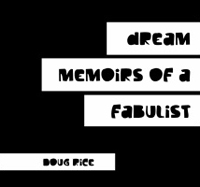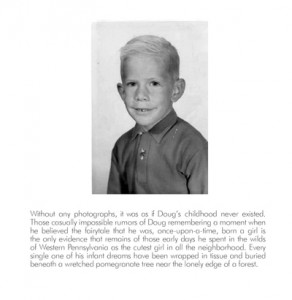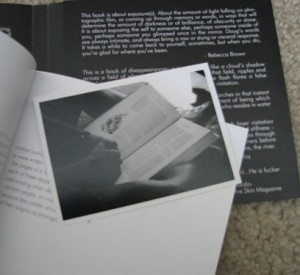 Dream Memoirs of a Fabulist
Dream Memoirs of a Fabulist
by Doug Rice
Copilot Press, 2011
$35 (Limited Edition) / Buy from Copilot Press
This book does not start with an I, but a ghostly he that becomes a she, that vanishes and becomes an I. In this body-text, the I perhaps does not exist as the reflection does, in this book that questions the naive categorizations of gender, the dizzying abyss of self-imposed identity, and the gravitational field of language itself, the pronouns textually speaking to one another, dragging memory from one space into another.
I’ve been interested in the topic of ghosts for awhile, the phantasmogenetic center of a text, the paranormal activity of writing. Reading Doug Rice’s book, I think of a ghost story.
I think especially of being dared as a child to stand in front of the bathroom mirror with the lights off, dared to repeat Bloody Mary 3 times. I didn’t like losing dares, so I would always splurt out the first two like sneezing: “Bloody Mary! Bloody Mary!” I would then declare the whole thing a load of BS and run out of the bathroom, looking for a new game to play. “Come on, this is stupid. There’s no such thing as ghosts anyway,” I’d say, grabbing a board game–any board game–off the top shelf to shove into the faces of my companions.
I know better now. There are ghosts; indeed, there are ghosts everywhere, corporeal spirits and phantasms overlapping with the ether of time, brushing against our shoulders after a bath, and dipping into our dreams when we are sleeping. This book reaffirms this.
With the persistence of a perpetual pendulum, my eyes roll over the words, language faded in some parts, backwards, like a reflection, in others. Does this text assert too much? Or too little? What is being born in the black womb of the page, the words crawling out to meet the reader: these are the words you are about to read: “It was almost as if the mirror did not work.”
I think too of the slow and gradual process of watching a photo develop, the colors crinkling inwards and outwards, a memory coming to life. Do we shake a Polaroid because we are ignorant to its effect? Or do we want to be in control of the memory that is about to be born, about to be reconsolidated into a tangible object, this loose photo of a boy standing in now for the memory of a little girl. Is that what I really used to look like? What do I look like now?
Dream Memoirs of a Fabulist begins with a photograph, presumably of Doug Rice as a child. Then, these words: “Without any photographs, it was as if Doug’s childhood never existed.”
And then later:
There is very little I can say about this book in words. Meaning, this book investigates the failure of language – “mirrors have become a spectacle of what language cannot think” – but also that language seems inadequate to describe the careful relationship that self and self that this text so beautifully and masterfully reveals. There is a boy lost inside a little girl. There is a girl lost inside a little boy. The author writes:
By nature sentences are innocent.
By nature mirrors are empty.
We fill mirrors with our gaze.
The conjuration of an identity transposed, transfixed upon another. Is gender really an identity? Or a way of interacting with the world? Or a way of thinking about one’s own body? Or a way of reading a text? Or a way of deciding what one sees when one looks into the mirror? Is that me or him or her or you?
And so what are we waiting for, when we stand there so patiently, shaking the Polaroid in one hand, carefully choosing the words for a testimony with the other. The gaze is of the witness, and the witness is trapped in the photograph, gazing back at himself, waiting for that which never arrives, only that which causes the present to move ever farther away. Creeping, creeping, tip-toeing away. Indeed, “When does a photograph begin to make sense again?”
The displacement of gender and identity and self are acted out through a ghost language, metaphorical in its beauty, spectral in its resonance, but acute in its precise slippage. The haunting of a memory that continually reinstates itself, the perpetual process of reconsolidation, reminds us that there is always an inherent paradox here when the ghost returns for the first time, it is also always beginning by coming back (David Appelbaum).
Mirrors are speechless with uncertainty. They exist without words for memory. They cannot hold to the past the way that skin and muscle is haunted by memory. At best, a mirror can create a moment that makes reminiscing possible but it can never invent time.
In my house, mirrors have begun to replace words. I live in silence and occasionally catch a glimpse of my desire for words in reflections before my image disappears. But these moments of seeing that which is not here, never endures. A mirror cannot replace the longing for the possibility of a photograph.
These words are reflected over, a “broken mirror of words,” emerging from the darkness only to be flipped over and reflected. Like an apparition, they move from darkness to lightness, but warped, reconsolidated, re-remembered, re-recalled.
And then, this book comes apart, seemingly torn at the edges, meant to be felt, the ragged edges of a book’s center ripped from its cover, the words cannot be contained in such a flimsy body. This book is meant to be felt, the points of weakness, the vulnerable points, the loose notes and photos tucked away for later but unable to be concisely integrated with the other pages. The senses of seeing and touching are different from our other senses. We tell people, we’ll believe it when we see it. But often we can see things that may not be real: ghosts, mirages, veridical hallucinations, the seeping of one reality into another. The sense of touch here seems a more rational sense, though we know that is not true either.
The book reminds us, while our fingers sweep over the pages, while our eyes glean the text, fading, disappearing at parts, that we cannot touch our reflections, no matter how fractured.
Peter Grandbois says of the book:
The book indeed demands a slowness that most books these days don’t, not because of the density of language, the complexity of syntax, or difficulty of abstraction, rather it simply asks for a pause from regular world and for the reader to delve into a world where words can be felt, touched, seen written in the mirror over your own reflection. What troubles you today? What troubles your access to memory? What does your memory look like in the mirror, drawn over your face, a photograph of your reflection?
If you looked into the mirror and saw words where a face should be, what would those words say?
***
More on the book here: Copilot Press.
Tags: copilot press, doug rice, dream memoirs of a fabulist, ghosts




There’s something intriguing about ‘memoirs’ and as this book seeks for your time, maybe there is indeed something that he what’s you to understand.
[…] Dream Memoirs of a Fabulist – by Doug Rice (Copilot Press, 2011) “She moved, like any other apparition, from darkness to light. It’s what makes a photograph possible.” – Read my review of it here. […]